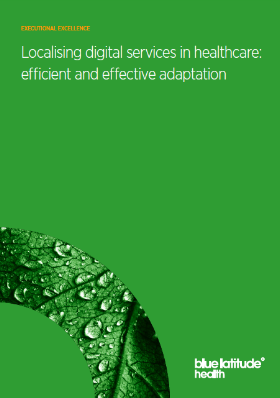Localising digital services in healthcare: efficient and effective adaptation
July 6, 2017 | Customer Engagement, Customer Experience, brand development, digital marketing, local markets
Head of Customer Experience Elisa del Galdo explains what localisation means and how pharma companies can effectively and efficiently develop and deploy their services, helping you overcome the challenge of different regions with diverse markets and customers.
Pharma companies are increasingly putting their marketing efforts into digital services, tools, and apps that are ‘beyond the pill’, in the hopes of creating better engagement from customers and improving patient outcomes.
These services are often developed at a global or regional level, with local markets expected to adopt and adapt for their own use.
But how can regional and global teams ensure that services are fit for purpose across geographically dispersed and culturally diverse markets and customers? And how can pharma companies ensure that the distribution of these digital initiatives is done in the most effective and efficient way possible: increasing speed to market, reducing the cost of adaptation, and maintaining consistency and quality within a framework of cultural and geographic requirements?
In order to provide a digital product for another market that is culturally different – even if it primarily uses the same language – adjustments need to be made to account for geographic and cultural norms, regulations, and laws.
This transformation of a product to suit a market for which it was not initially designed is referred to as localisation and, if not taken into consideration early and hence done poorly, can significantly reduce the product’s uptake and return on investment.
Head of Customer Experience Elisa del Galdo explains what localisation entails, and how pharma companies can more effectively and efficiently develop and deploy their services.
Localisation kits facilitate efficient and consistent adaptation of services for foreign markets
Until the mid-1980s, the localisation of digital products was new, difficult, and inefficient – an international company could spend as much as the original development costs to re-engineer a US produced product for a foreign market.
It took a lot of effort to transform a product into a version that was acceptable for a foreign market, and the result was not always of a quality that could compete with locally-developed products.
This resulted in decreased adoption rates for digital products and services when deployed to foreign markets, especially when there was a local alternative.
Markets saw poorly localised products as being clearly ‘not created for me’. The drive to produce or transform digital products into ones perceived by foreign markets as ‘made for them’ was increased as a result of growing competition within local markets.
Previously, there may have been little or no competition within a local market, presenting an open window of opportunity.Successful deployment and adaptation of a centrally-created digital product or service hinges on a number of factors:
- Consistent and accurate translation (both of the system and content) to the local language, in the appropriate voice
- Adherence to local legal and medical regulations
- Accommodation of geographic and cultural differences and norms
- Ease of transforming the offering across all of the above
- Customer experience of using the product or service that is in keeping with the requirements of the customer.
Simply put, a localisation kit ensures that services created in a single market (or specifically for an international market) can be transformed efficiently, effectively, and consistently by multiple markets.
What’s included in a localisation kit?
A localisation kit typically contains:
- Culturally neutral, flexible, and adaptable user interface designs
- Culturally neutral content, which the service may be providing
- The service code, which is easily adaptable to translation and localisation – sometimes referred to as a ‘base version’
- Previous translations of the service and its content
- A translation glossary for industry-specific terminology, to assist with idiomatic or local expression translations
- A process and governance for localisation, which is normally governed by a CMS in larger projects.
All of these components help to speed up localisation and ensure quality and consistency across local versions of the service. However, the success of a digital product or service in a healthcare context is more complicated than just getting the translations and regulatory issues right – there is also the customer experience to consider.

Download the full article from Blue Latitude Health
This content was provided by Blue Latitude Health




